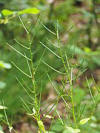

_small.jpg)



WILD
FOODIES' HOME PAGE
PLANT PROFILE LIST
NAME: Garlic Mustard
SPECIES / FAMILY: Alliaria petiolata / Brassicaceae or Cruciferae
OTHER COMMON NAME(S): Jack-by-the-hedge
CONDITIONS:
mostly shade
|
PARTS: |
EDIBLE |
TASTE |
RAW/COOK |
SEASON |
|
All |
|
|
|
|
|
Shoots |
|
|
|
|
|
Leaves |
|
garlic/mustard |
COOK |
Spring-Fall |
|
Flowers |
|
|
RAW/COOK |
|
|
Fruits |
|
|
|
|
|
Roots |
|
|
|
|
|
Seeds |
|
|
RAW/COOK |
|
|
Nuts |
|
|
|
|
|
Pods |
|
|
|
|
|
Stalk/Stem |
|
|
|
|
|
Bark |
|
|
|
|
PORTION: small
COMMENT: Perfectly named plant - the leaves taste like a combination of garlic and mustard. Two-year plant (biennial). Some people only use young leaves before the plant flowers, and then cook the leaves, which reportedly minimizes cyanide content. If used raw as a pesto, you may want to add bland greens like wild violet and mallow, particularly if you are a vegan and don't use dairy products.
CAUTIONS: Contains small amounts of cyanide, as with other members of the Mustard/Brassicaceae and other plants. Some people may be sensitive to it no matter how it is processed. Soaking and cooking is reported to minimize. You can throw off the water twice, for soaking and cooking, to be double careful. (5) Best eaten with bland foods. Some people only use young leaves before the plant flowers. Others also eat the roots as a horseradish substitute - first year roots are most tender.
NUTRITION/MEDICINAL: The leaves are also believed to strengthen the digestive system. They are rich in vitamin C and A and medicinally was used for treating gangrene and ulcers.(2) Antiasthmatic; Antiscorbutic; Antiseptic; Deobstruent; Diaphoretic; Sternutatory; Vermifuge; Vulnerary.(1) https://www.outdoorapothecary.com/garlic-mustard-weed Garlic mustard weed is a member of the cruciferous vegetable group. It is high in vitamins C, A, and E. It also contains fiber, calcium, copper, iron, magnesium, and manganese. In short, garlic mustard weed is a nutritional powerhouse and an excellent healthy green vegetable.
LOOK-A-LIKES: When very young, looks a bit like wild violet or ground ivy.
POISONOUS LOOK-A-LIKES:
OTHER USES: Dye. A yellow dye is obtained from the whole plant.(1)
SOURCE LINKS (may include nutritional and medicinal info, plus other uses):